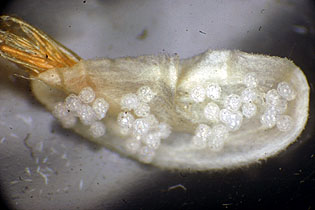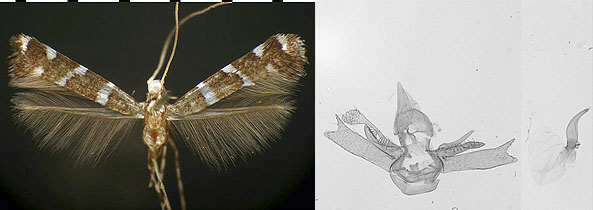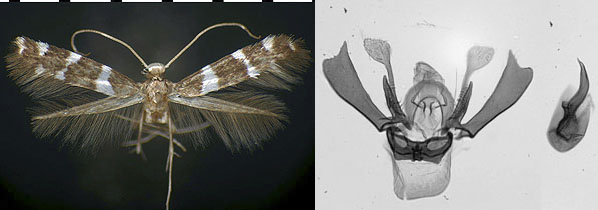
Larvae of Marmara make serpentine track mines (similar to those of Phyllocnistis and of Nepticulidae) on both forbs and woody plants. They usually mine on shoots or stems, rather than on leaves; some species mine on the fruit of such plants as sweet orange, Citrus sinensis (Rutaceae). The larva usually leaves the mine to pupate. For reasons that are not clearly understood, once the larva is inside its cocoon, it adorns the cocoon with a series of frothy "bubbles" that are produced from the posterior end of its digestive tract and then pushed out through cuts in the cocoon wall, onto the exterior of the cocoon (Fig. 1). Adults are distinctive in appearance, being strikingly patterned and usually colored in brown, black, and white. Several species are known from Illinois.

Figure 1. Marmara opuntiella. Cocoon (adult moth already emerged, as indicated by protruded pupal exuvium), showing the characteristic "bubbles" with which the larva adorns the exterior of the cocoon. Specimen courtesy of Dr. David Wagner, via Dr. Steven Passoa, ex cladode-mining larva reared on prickly-pear cactus, Opuntia sp. (Cactaceae).
In the images below, all genitalia photos are taken at the same scale, so that actual relative sizes are seen here.
Marmara fasciella (Fig. 2) is probably the most commonly-seen species at light in Illinois.

Figure 2. Marmara fasciella. Left, male adult, collected at light; right, genitalia.
Marmara fulgidella (Fig. 3) feeds as a larva on oak, Quercus prinus (Fagaceae).

Figure 3. Marmara fulgidella. Left, male adult, collected at light; right, genitalia.
Several additional species are known from Illinois. The following two species are similar in appearance but markedly different on male genital morphology.
Marmara sp. 1 (Fig. 4).

Figure 4. Marmara sp. 1. Left, male adult, collected at light; right, genitalia.
Marmara sp. 2 (Fig. 5).

Figure 5. Marmara sp. 2. Left, male adult, collected at light; right, genitalia.
As with spp. 1 and 2 above, the following two species are similar in appearance but different on male genital morphology.
Marmara sp. 3 (Fig. 6).

Figure 6. Marmara sp. 3. Left, male adult, collected at light; right, genitalia (symmetrical in perfect state; in this preparation, the dilated apical area of the dorsal process on the right-hand side is broken off).
Marmara sp. 4 (Fig. 7).

Figure 7. Marmara sp. 4. Left, male adult, collected at light; right, genitalia.
Back to Gracillariinae